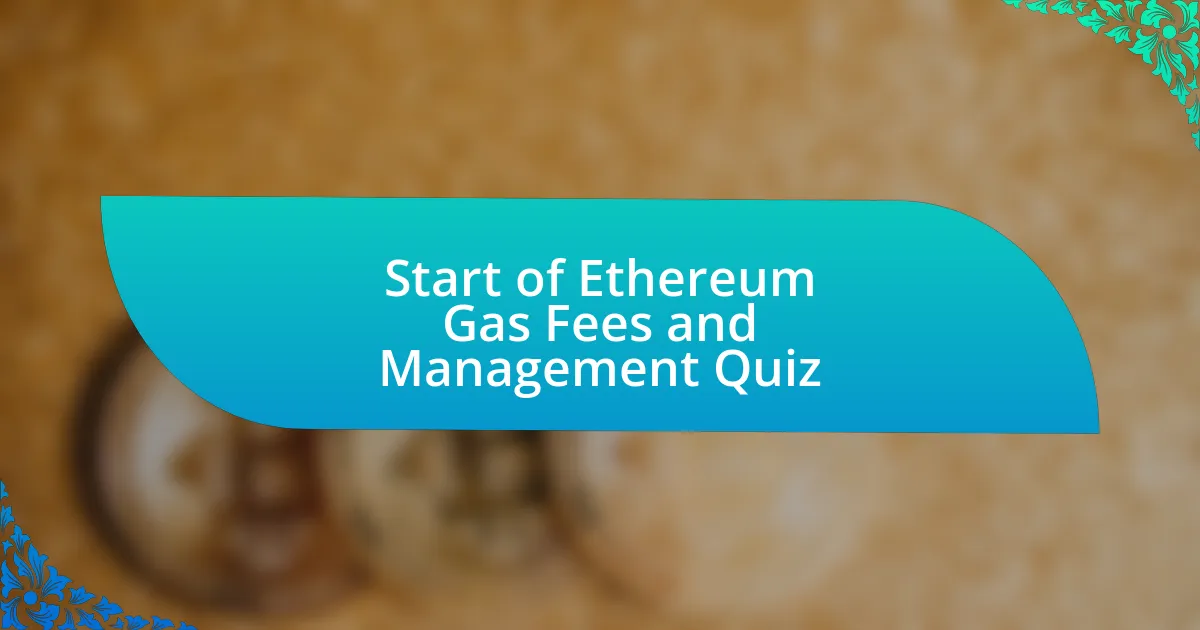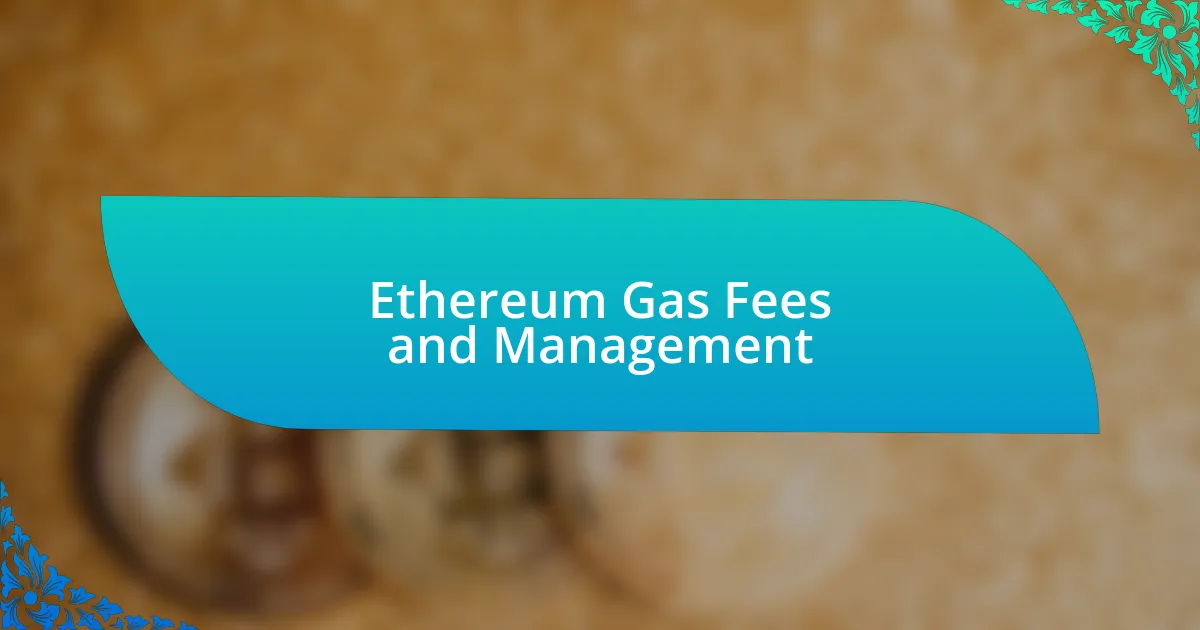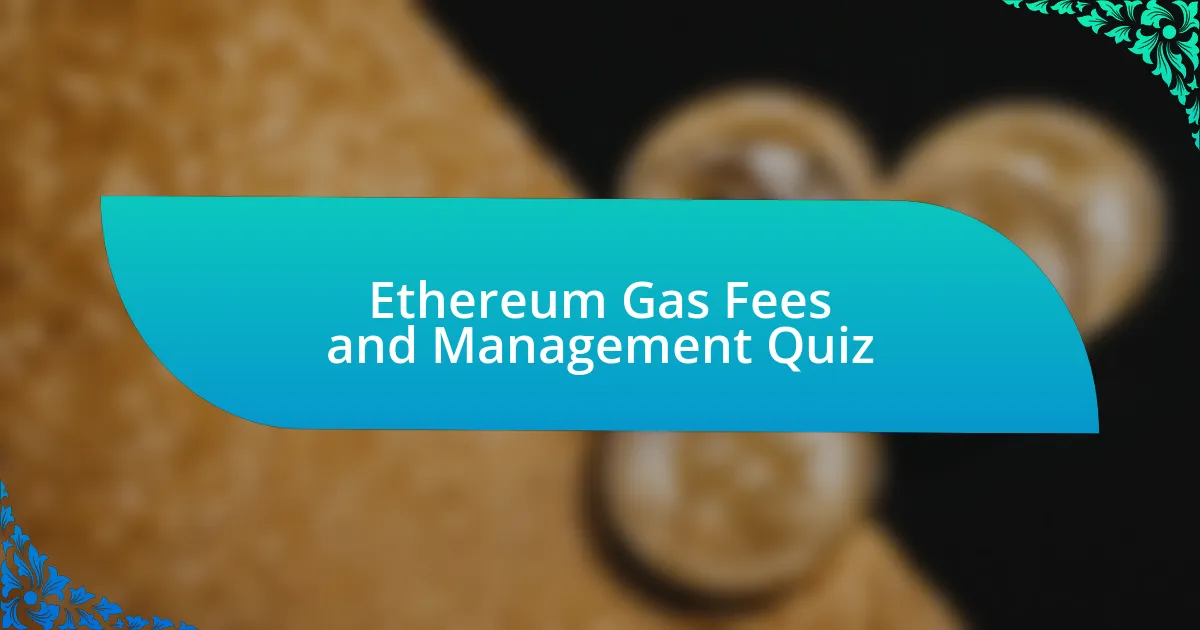
Start of Ethereum Gas Fees and Management Quiz
1. What is gas in the context of Ethereum?
- Gas is a type of cryptocurrency used for trading on Ethereum.
- Gas is the fee required to successfully conduct a transaction or execute a contract on the Ethereum blockchain platform.
- Gas is a protocol for storing data on the Ethereum blockchain.
- Gas is a social media platform built on the Ethereum network.
2. How are gas fees priced on the Ethereum network?
- Gas fees are determined solely by the amount of ETH held by the user.
- Gas fees are priced in tiny fractions of ether called gwei.
- Gas fees are fixed, regardless of network activity.
- Gas fees are calculated based on transaction volume in USD.
3. What exactly are gwei in Ethereum transactions?
- Gwei are tiny fractions of ether (ETH), equal to one billionth of an ETH.
- Gwei are a type of token used for staking in Ethereum.
- Gwei are the total gas fees paid for transactions in Ethereum.
- Gwei are large denominations of ether (ETH), equal to one millionth of an ETH.
4. Who is responsible for paying validators for transaction execution on Ethereum?
- Miners
- Developers
- Users
- Validators
5. What factors determine the exact price of gas fees?
- The exact price of gas is determined by the type of transaction being made.
- The exact price of gas is determined by the day of the week the transaction occurs.
- The exact price of gas is determined by supply, demand, and network capacity at the time of the transaction.
- The exact price of gas is determined by the user`s transaction history and account balance.
6. What key points should one know about gas fees on Ethereum?
- Gas prices are based on supply and demand for the network`s validation requests, transaction prices are based on the gas limit and gas price, and transaction prices are denoted in tiny fractions of ether called gwei or ETH.
- Gas fees are only paid during peak demand hours, not at other times.
- Gas prices are fixed and do not vary based on network activity or transaction type.
- All transactions on Ethereum have the same gas price regardless of complexity or time.
7. What was the original method for calculating gas fees?
- Originally, gas fees were calculated using a gas limit and the gas price per unit.
- Gas fees were determined solely by the number of transactions in a block.
- Gas fees were calculated based on the total transaction value only.
- Gas fees were calculated using a flat rate regardless of the transaction type.
8. What significant changes were made to gas fee calculations in August 2021?
- Ethereum removed the gas fee structure entirely in August 2021.
- Ethereum introduced a flat-rate fee for all transactions after August 2021.
- Ethereum updated its calculations to include a base fee and priority fee for gas fees.
- Ethereum fixed gas fees at a constant rate for all transactions.
9. Can you provide the formula for calculating gas fees after August 2021?
- Transaction Amount / Gas Limit
- Units of Gas Used * (Base Fee + Priority Fee)
- Base Fee + Transaction Amount
- Gas Limit + Eth Value
10. How is the gas fee for a specific Ethereum transaction determined?
- The gas fee is determined by multiplying the units of gas used by the sum of the base fee and the priority fee.
- The gas fee is solely based on the user`s wallet balance.
- The gas fee is calculated by dividing the amount of ETH being sent by the network speed.
- The gas fee is fixed and does not change between transactions.
11. What is the base fee in Ethereum gas fee calculations?
- The base fee is a flat rate that doesn`t change based on network activity.
- The base fee is a fee set by individual users for their transactions.
- The base fee is a minimum price for gas that is determined algorithmically based on the real demand for blockspace on the Ethereum network.
- The base fee is a fee solely based on the Ethereum price in USD.
12. What happens to the base fee that is charged for gas on Ethereum?
- The base fee is stored in a separate wallet for later use.
- The base fee is paid to the developers of Ethereum.
- The base fee is burned to reduce the amount of ETH in circulation.
- The base fee is refunded to users for future transactions.
13. What does the priority fee entail in gas fee management?
- The priority fee is an additional tip to speed up transaction processing.
- The priority fee is a refund issued by the network.
- The priority fee is a penalty for late transactions.
- The priority fee is a fixed cost for all transactions.
14. What are some effective ways to reduce Ethereum gas fees?
- Monitoring gas prices and timing transactions during off-peak hours can reduce gas fees.
- Using outdated gas fee estimators offers more savings on transactions.
- Transferring ETH to multiple wallets at once effectively increases gas fees.
- Ignoring network congestion always results in lower gas fees.
15. How do layer-2 solutions help in decreasing gas fees?
- Layer-2 solutions process transactions off-chain and reduce costs.
- Layer-2 solutions increase the number of validators on the network.
- Layer-2 solutions change the cryptocurrency used for transactions.
- Layer-2 solutions move the entire blockchain to a different server.
16. Can you name a few layer-2 scaling solutions for Ethereum?
- Optimistic Rollups
- Solana Network
- Ethereum Classic
- Bitcoin Lightning
17. What tools can you use to monitor current Ethereum gas prices?
- Coinbase Exchange
- Etherscan’s Gas Tracker
- MetaMask Wallet
- Uniswap DApp
18. What is the strategy of `wait and watch` in the realm of gas fee management?
- The `wait and watch` strategy focuses on making transactions as quickly as possible at any price.
- The `wait and watch` strategy involves investing in the network when the gas price is at its lowest.
- The `wait and watch` strategy is about paying gas fees at midnight regardless of price.
- The `wait and watch` strategy requires constant monitoring of the blockchain without acting on price.
19. In what way does network demand influence gas prices on Ethereum?
- The more traffic there is in the Ethereum ecosystem, the higher the price will be.
- Demand solely determines the number of validators active on the network.
- Network capacity remains constant regardless of demand.
- Gas prices are fixed and do not change with network activity.
20. What is the minimum required gas for sending ETH from one account to another?
- 100,000
- 10,000
- 21,000
- 50,000
21. How can you calculate the total cost of gas for an Ethereum transaction?
- Total ETH in Wallet / Gas Price
- Gas Limit + Transaction Cost
- Base Fee – Priority Fee
- Units of Gas Used * (Base Fee + Priority Fee)
22. What is the connection between gwei and ether (ETH)?
- Gwei is a type of Ethereum wallet.
- One gwei is one billionth of an ETH.
- Gwei refers to the amount of ETH you can borrow.
- Gwei is a transaction limit on the Ethereum network.
23. How do you translate gas fees into USD values?
- You subtract your result from the current Ether price.
- You multiply your result by the current Ether price.
- You add your result to the current Ether price.
- You divide your result by the current Ether price.
24. What effective strategies exist for managing Ethereum gas fees?
- Ignoring gas fees altogether
- Using only Ethereum mainnet for all transactions
- Paying gas fees exclusively in USD
- Monitoring gas prices and timing transactions during off-peak hours
25. How do solutions like Optimism and Arbitrum impact gas fee levels?
- They increase gas fees by requiring additional on-chain confirmations for every transaction.
- They eliminate gas fees entirely by using a different blockchain.
- These solutions significantly reduce gas fees by processing transactions off-chain and only settling them on the main Ethereum network.
- They have no effect on gas fees, as all transactions are processed on-chain.
26. What is the role of the `tip` in Ethereum gas fee calculations?
- The tip is an optional donation to the Ethereum development team.
- The tip is a priority fee that increases the chances of your transaction being processed faster.
- The tip is an additional fee that is not factored into the calculations.
- The tip is a fixed amount paid to all validators regardless of transaction.
27. How do the base fee and priority fee work together in gas fees?
- The base fee is the minimum price for gas, while the final fee is an additional tip to prioritize the transaction processing.
- The base fee and final fee are combined into a single payment that is charged after the transaction is completed.
- The base fee is determined by network validators, while the final fee is set by users based on their preferences.
- The base fee is a fixed amount, and the final fee is a percentage calculated from the transaction total.
28. What happens if a user fails to pay sufficient gas for their transaction?
- The user is charged a fine.
- The gas fee is automatically increased.
- The transaction goes through with no issues.
- The transaction fails and is not submitted.
29. How do complex transactions contribute to higher gas fees?
- Higher gas fees apply only during network downtime.
- Simple transactions are more expensive than complex transactions.
- Complex transactions require more computational resources, leading to higher gas fees.
- Complex transactions are always free of gas fees.
30. Why do Ethereum gas fees tend to be elevated compared to other blockchains?
- Ethereum uses a different currency that reduces costs.
- Ethereum has lower security than other blockchains.
- Ethereum has a complex network that supports diverse applications.
- Ethereum transactions are simpler and require less verification.

Congratulations on Completing the Quiz!
You’ve just finished the quiz on Ethereum gas fees and management. This topic is crucial for anyone engaging with the Ethereum network. Understanding these concepts helps you manage costs effectively when executing transactions. You’ve likely learned about the significance of gas prices and how they fluctuate based on network demand. This knowledge is key for optimizing your transactions and ensuring you are not overpaying for gas.
Moreover, the quiz has likely deepened your understanding of various tools and strategies to manage gas fees. You may now be more familiar with the impact of transaction complexity on gas usage. This awareness can help you decide when to execute a transaction for the best price. The insights gained here can empower you in your Ethereum journey.
If you’re keen to enhance your understanding further, we invite you to check out the next section on this page. It contains a wealth of information on Ethereum gas fees and management. The more you know, the better you can navigate the Ethereum landscape. Happy learning!

Ethereum Gas Fees and Management
Understanding Ethereum Gas Fees
Ethereum gas fees are the costs associated with executing transactions or smart contracts on the Ethereum blockchain. This fee compensates miners for the computational power required to process transactions. Gas fees are measured in gwei, a denomination of Ethereum (ETH). As network activity increases, gas fees can spike due to higher demand for transaction processing. When users set a higher gas price, their transactions are prioritized by miners. Hence, fluctuations in gas fees reflect the network’s congestion and the urgency of transaction execution.
Factors Influencing Ethereum Gas Prices
Several factors impact Ethereum gas prices. Network congestion is a primary factor; when many users transact simultaneously, prices rise. The complexity of the transaction also plays a role; more complex contracts require more computational resources and thus incur higher fees. Lastly, gas prices vary based on the miner’s current rates. Users can estimate gas prices through Ethereum gas trackers that monitor real-time fees, enhancing their ability to execute transactions at optimal costs.
Strategies for Managing Ethereum Gas Fees
Effective management of Ethereum gas fees involves timing and setting appropriate gas limits. Users can monitor network activity to identify low-traffic periods, often resulting in lower fees. Additionally, using wallet features that allow for gas price customization enables users to choose a price that balances speed and cost. Employing layer-2 solutions and alternative protocols, like Polygon, can also significantly reduce fees while maintaining transaction speed.
Gas Limit and Its Importance in Transactions
The gas limit is the maximum amount of gas a user is willing to spend on a transaction. It ensures that a transaction does not consume more resources than intended. If the gas limit is set too low, the transaction may fail or revert, costing the user the gas spent. Properly estimating the gas limit is crucial for executing successful transactions while minimizing unnecessary costs. Wallets often provide recommended gas limits based on current network conditions to assist users in this estimation.
The Role of EIP-1559 in Gas Fee Management
EIP-1559, implemented in August 2021, transformed Ethereum’s fee market by introducing a base fee mechanism. This protocol automatically adjusts the base fee based on network congestion, making gas fees more predictable. Users still have the option to tip miners, ensuring their transactions are prioritized. EIP-1559 aims to reduce volatility in gas fees and improve the overall user experience by lowering the uncertainty often associated with blockchain transactions.
What are Ethereum gas fees?
Ethereum gas fees are the costs incurred for executing transactions and smart contracts on the Ethereum blockchain. These fees are paid in Gwei, which is a denomination of Ether (ETH). Gas fees fluctuate based on network demand, with higher activity leading to increased costs. For example, during peak periods, like the DeFi boom in 2020, fees surged to record highs, highlighting how congestion affects pricing.
How are Ethereum gas fees calculated?
Ethereum gas fees are calculated based on two main factors: gas limit and gas price. The gas limit is the maximum amount of computational work a user is willing to pay for a transaction, while the gas price represents the cost per unit of gas, determined by market supply and demand. For instance, if a transaction requires 21,000 gas and the gas price is 100 Gwei, the total fee would be 2,100,000 Gwei or 0.0021 ETH.
Where can users check Ethereum gas fees?
Users can check Ethereum gas fees on various blockchain explorers and gas tracking websites, such as ETH Gas Station or Etherscan. These platforms provide real-time data on current gas prices, average fees, and estimated transaction times, helping users make informed decisions when transacting. They utilize data directly from the Ethereum network to present accurate figures.
When do Ethereum gas fees typically rise?
Ethereum gas fees typically rise during periods of increased network activity or congestion. This can occur during major events, such as NFT drops or DeFi launches, where many users transact simultaneously. Historical data shows spikes in fees during events like the JPEG stock market volatility in 2021 and the launch of popular tokens, indicating a direct correlation between demand and gas prices.
Who sets the Ethereum gas fees?
Ethereum gas fees are set by users through the gas price they are willing to pay for their transactions. Miners prioritize transactions with higher gas prices, incentivizing users to bid more during times of high demand. This market-driven approach leads to fluctuations as users react to current network conditions, evidenced by changes in gas prices reported by platforms like GasNow.

